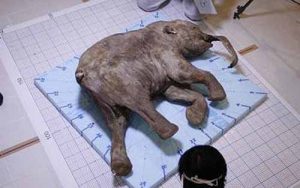Feb 28 2017
De-Extinction

Recently Harvard University geneticist Prof George Church announced that he and his team are close to making a mammoth-elephant hybrid. They have been reconstructing mammoth DNA from frozen remains.
They will not be able to make a 100% mammoth clone, but rather they are splicing mammoth genes into Indian elephant DNA and hope to grow a hybrid. The result would have, they hope, enough mammoth traits to be adapted to a colder environment, and therefore essentially spread the range of the Indian elephant north.
Such programs raise two question – can we actually achieve de-extinction with such techniques, and should we?
The answer to the first question is – we’re not even close yet. The reporting of Church’s announcement was highly sensationalized, with many outlets reporting that we will have mammoths in two year. The reality is that Church’s team has made 45 mammoth DNA inserts into the Indian elephant genome. This is insignificant.
Estimates of the differences between mammoth and elephant DNA indicate that several thousand genes are involved. In addition, there may be even more regulatory changes in the DNA outside of genes. You can make a lot of evolutionary change by turning on or off, or up or down, the expression of genes without changing the genes themselves.
A more sober assessment is that we are nowhere near cloning any extinct species, and the mammoth is likely the one in which we have made the most progress. Two years? No way. Twenty years? Probably not, but it is hard to say because the pace of advancement in genetic science has been very rapid. Look at CRISPR. Will similar breakthroughs be made in the next 20 years?
We still need to research more about how genes are regulated. That research alone will probably take decades. But I do think eventually we will have the knowledge and technology to make clones or at least hybrids of currently extinct species.
We also should be banking the DNA profiles of endangered species.
When we finally have the technology, should we?
I think the short answer is yes, but there is a lot of complexity here. In a recent commentary, University of Queensland Professor Hugh Possingham said the research suggested further stretching already-strained conservation budgets to cover the costs of de-extinction could endanger extant species.
Opportunity costs are one of those things that are often neglected to consider. We are not always operating in a zero-sum game, but when we are , or close to it, everything we do comes at the cost of other opportunities not exploited.
Possingham’s concern assumes a zero-sum game in which resources spent on de-extinction would not be spent on preserving extant but threatened species. This says nothing, however, about spending additional resources on de-extinction efforts.
Those efforts might be worthwhile in their own right. Certainly they will be scientifically interesting. There may also be certain critical species that would have a significant impact on their ecosystem, and reestablishing a population could benefit many other species.
Further, bringing back a species does not necessarily mean establishing a breeding population in the wild. We could establish a breeding population confined to zoos and preserves (the Jurassic Park model). Therefore we don’t have to consider their impact on the ecosystem.
It makes the most sense to focus our de-extinction efforts on recently extinct species, especially those who went extinct because of recent human activity. We can undo some of the damage we have done, and the environments to which such animals were adapted still largely exist.
Mammoths went extinct mostly around 10,000 years ago (some isolated populations survived longer), during the last glacial period. They would still find a home in the tundra, however.
Tens of thousands of years is probably the farthest back we can go. Given DNA’s half life, we could not resurrect animals extinct for millions of years. Dinosaurs are simply not possible.
There are researchers working on, essentially, simulating dinosaurs by trying to reverse the evolutionary changes that resulted in birds. In essence, birds contain fossil dinosaur DNA. (BTW, in Jurassic Park, why the hell did they splice dino DNA into frogs and not birds?) Of course, knowing which evolutionary changes to reverse will take a lot of research. Some information is also lost and not preserved. But it probably is possible to eventually create a very dinosaur-like chicken.
I reject that Jurassic Park movie argument that animals that are extinct were “meant” to go extinct and we should not “play God.” That is Hollywood simplistic nonsense.
We should carefully consider the ramifications of de-extinction, or making hybrids simulating extinct species. Megafauna with a slow reproduction rate, however, are unlikely to wreak havoc on an ecosystem. It will probably be hard to keep these creatures alive, and get them to breed (which might not even be possible).
I would be more worried about engineering insects, bacteria, or viruses.
The most controversial de-extinction, which I have never heard anyone seriously propose, would be to bring back Neanderthals (we have their DNA). As fascinating as that would be scientifically, I think the ethics are too dubious.
While de-extinction is still probably decades away, it may happen faster that we think. Now is the time to think about the logistics of what we can and will create, what we will do with them, and how we will pay for it.






